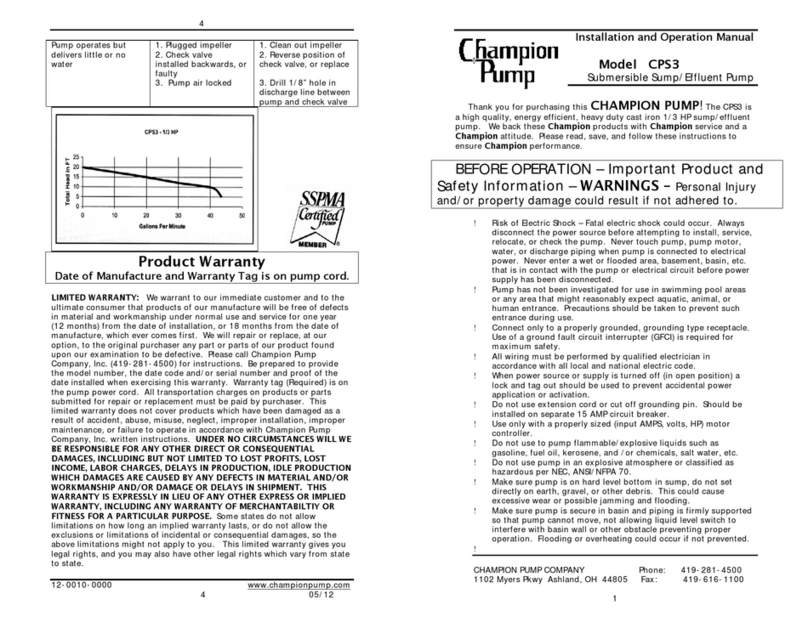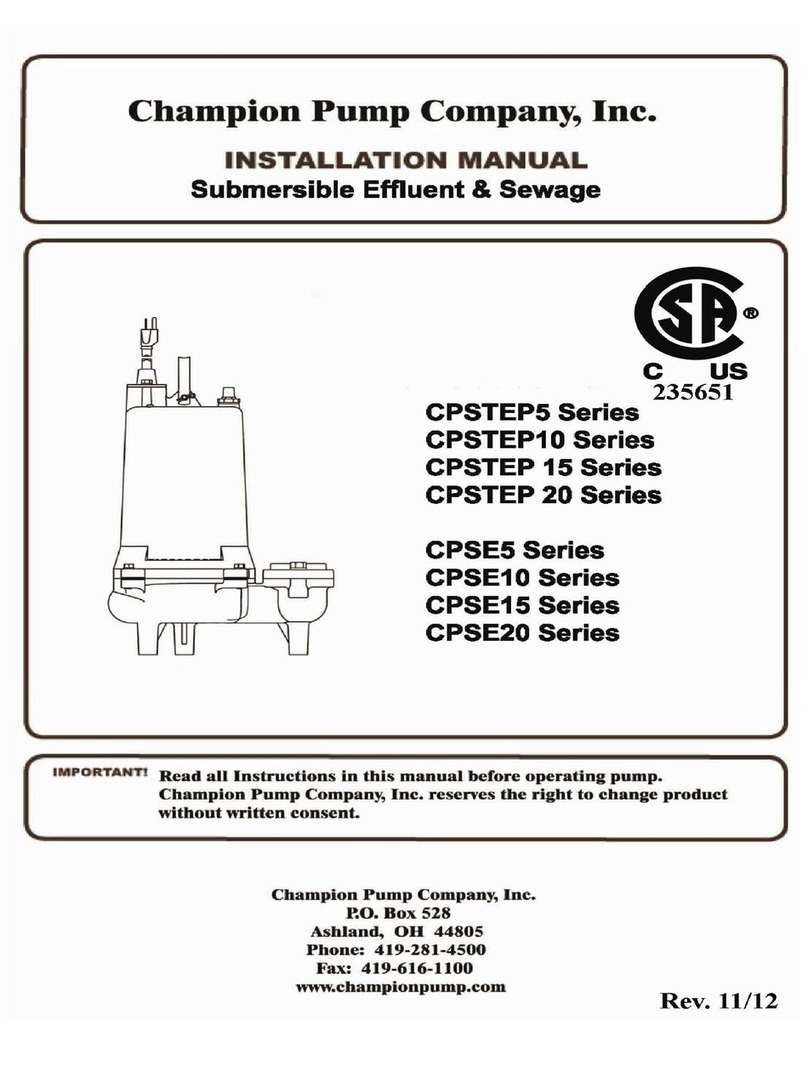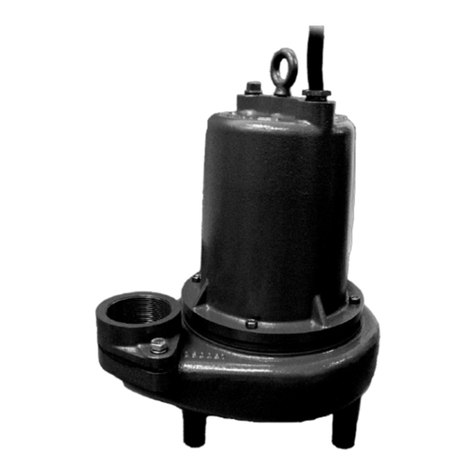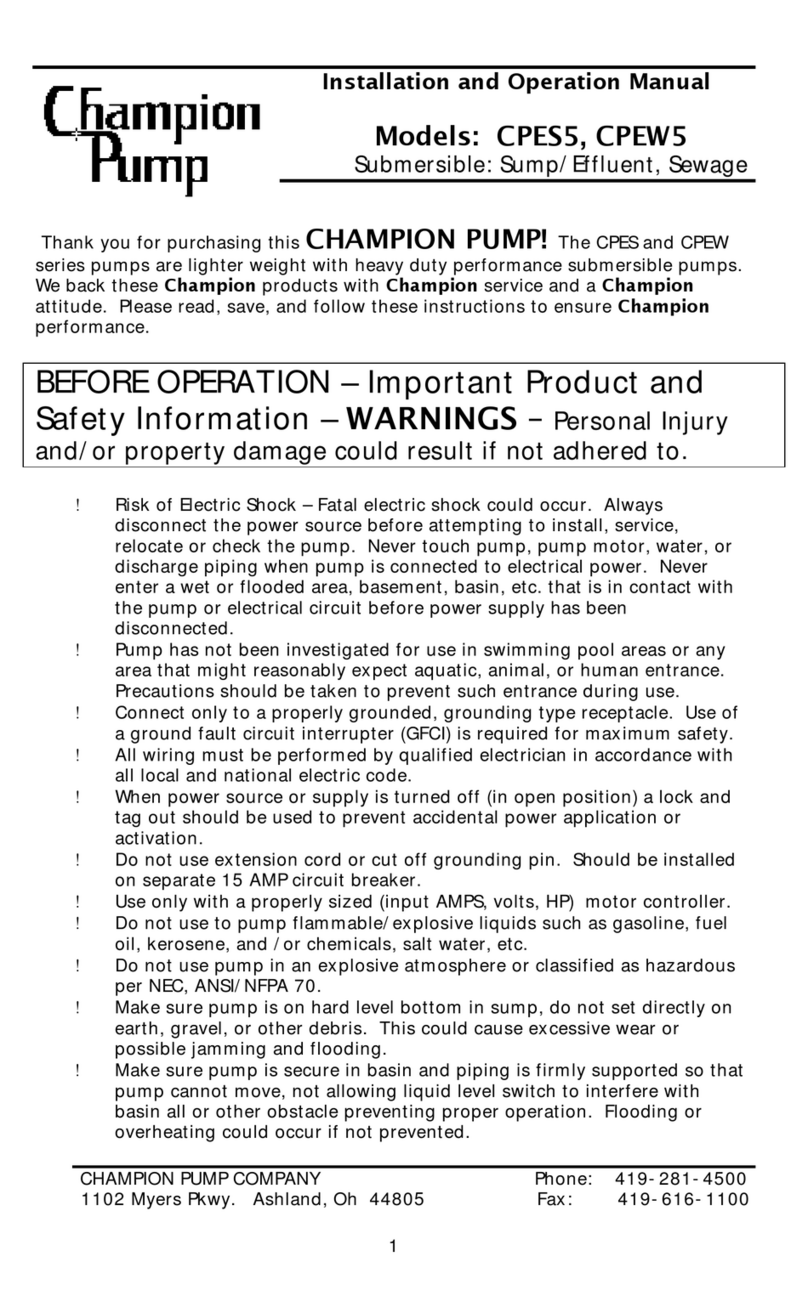
Page 4
USER GUIDE
INSTALLATION
The pump is provided with a leg kit in case a rail lift out system is not used. A minimum of 3” clearance must be maintained
between the pump and the basin bottom. If the feet are to be used, install the rubber threaded feet and lock with nut to ensure
3” clearance under pump for proper clearance of solids to enter pump inlet.
Assemble discharge piping or hose assembly to the pump. Discharge piping should be as short as possible. Both a check
valve and a shut off valve are required for each pump being used. The check valve is used to prevent backflow into the sump.
Excessive backflow can cause flooding and /or damage to the pump. The shut-off valve is used to stop system flow during
pump or check valve servicing. If pump is installed with a discharge hose rather than a moveable fitting assembly, make sure
the discharge pipe has a 1/8” hole approximately 5” from tend neatest volute and oriented towards the pump body.
ELECTRICAL CONNECTIONS
Breaker Recommendations: 25 AMP (208V-230V Single Phase) : 20AMP (208V-230V Three Phase) :15AMP (460V Three
Phase). The quick connect cord assembly mounted to the pump must not be modified in any way except for shortening to a
specific application. Any supply cables connections between the pump and the control panel must be made in accordance with
the National Electric Code or the Canadian Electric Code and all applicable state, province and local electric codes. It is
recommended that a junction box, be mounted outside the sump or be of at least Nema 4 (EEMAC-4) construction if located
within the wet well. The Ground Wire of pump is marked with an “E” for earth ground and is a Blue-Green Color. DO NOT
USE THE POWER OR CONTROL CABLES TO LIFT PUMP!
Check winding resistance of pump power cable before installation. The OHM readings should be approximately: CPG2022DS
Models: Black to White or across blades -1.3ohms; GPG2022DSL Models: Black to White – 1.3ohms; Red to White –
3.7ohms; Black to Red – 2.4ohms.
THREE PHASE GRINDER INSTALLATION: Check proper rotation. Improper motor rotation can result in poor pump
performance and pump failure. The power leads are the red, black and white wires. There should be approximately an equal
ohm resistance between these leads of approximately 1.6ohms for 230 Volt connection and 6.2 ohms for 460Volt. The blue-
green color lead is the ground wire. Once the leads are connected to the power terminals then you are ready to check the
rotation. Momentarily apply power to the pump with it laying on its side and impeller clear from obstruction. Observe
“kickback” as it should always be in counter-clockwise direction as viewed from top of the motor housing or opposite to
impeller rotation. If rotation is incorrect when power is supplied, then reverse two of the leads at the power terminal and try
again. This should correct the rotation. Once pump is in operation the amperage of each leg of the power connection should be
checked and recorded on the start up sheet. They should be close to the same value for each leg (within 5% of the average leg
to leg value). If they are not, try advancing the connections to balance the readings, but do not lose proper rotation.
If additional cord is required, consult a qualified electrician for proper wire size. On single phase models, the type of in-
winding overload protector used is referred to as an inherent overheating protector and operates on the combined effect of
temperature and current. This means that the overload protector will trip out and shut the pump off if the winding becomes too
hot, or the load current passing through them becomes too high. It will then automatically reset and start the pump up after the
motor cools to a safe temperature. All three phase models are not automatically protected. They do have on winding thermal
sensors accessed through the sensor cord (Black and Green wires) that need to be connected to an approved protection and or
alarm circuitry in the panel for winding thermal protection. Thermal protection shall not be used as a motor overload
device. A separate motor overload device must be provided in accordance with NEC codes. In the event of an overload,
the source of this condition should be determined and rectified immediately. DO NOT LET THE PUMP CONTINUE TO
RUN IF AN OVERLOAD CONDITION OCCURS. Full load amps are 15 amps for 230 Volt single phase; 17amps for 208
Volt single phase; 11.0, 9.0, & 4.5 amps for 208V, 230V, & 460V three phase models.
OPTIONAL MOISTURE SENSOR A detector is installed in the pump seal chamber which will detect any moisture present. It
is recommended that this detector (Black & White wires) be connected in series to an alarm device or the motor starter coil to
alert the operator that a moisture detect has occurred. In the event of a moisture detect, check the individual moisture sensor
probe leads for continuity and the junction box/control box for moisture content. This situation may induce a false signal in
the moisture detecting circuit. Normal resistance between leads is 33,000 OHMS indicating normal connection. When the
resistance drops well below 33,000 OHMS, then moisture is present and the pump seals should be serviced. If none of the
above tests prove conclusive, the pump(s) should be pulled and the source of the failure identified and repaired. IF A
MOISTURE DETECT HAS OCCURRED, SCHEDULE MAINTENANCE AS SOON AS POSSIBLE.








































